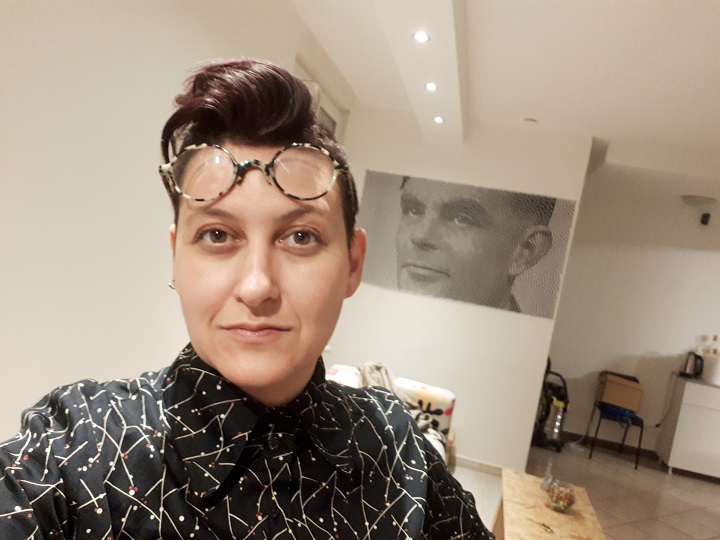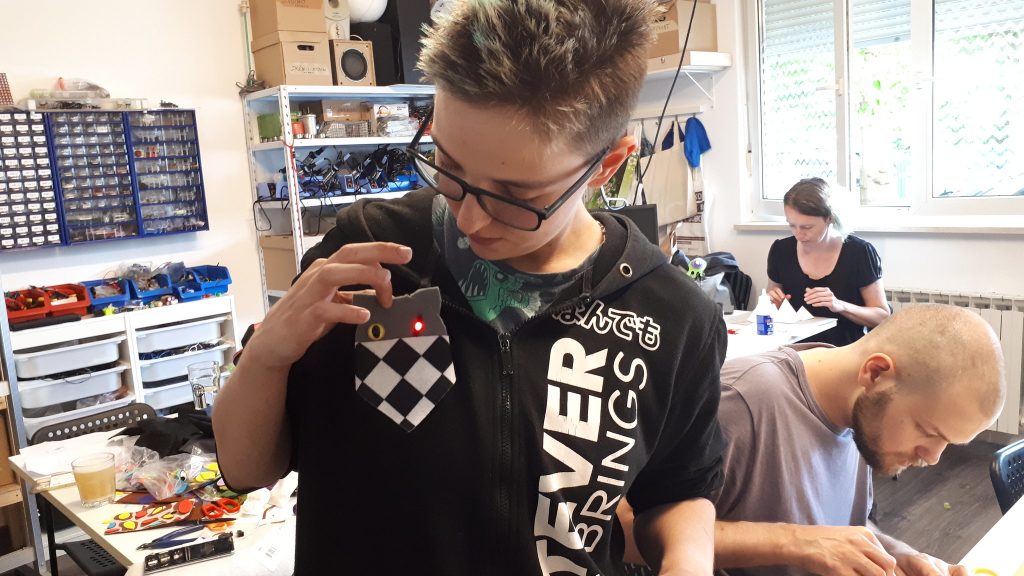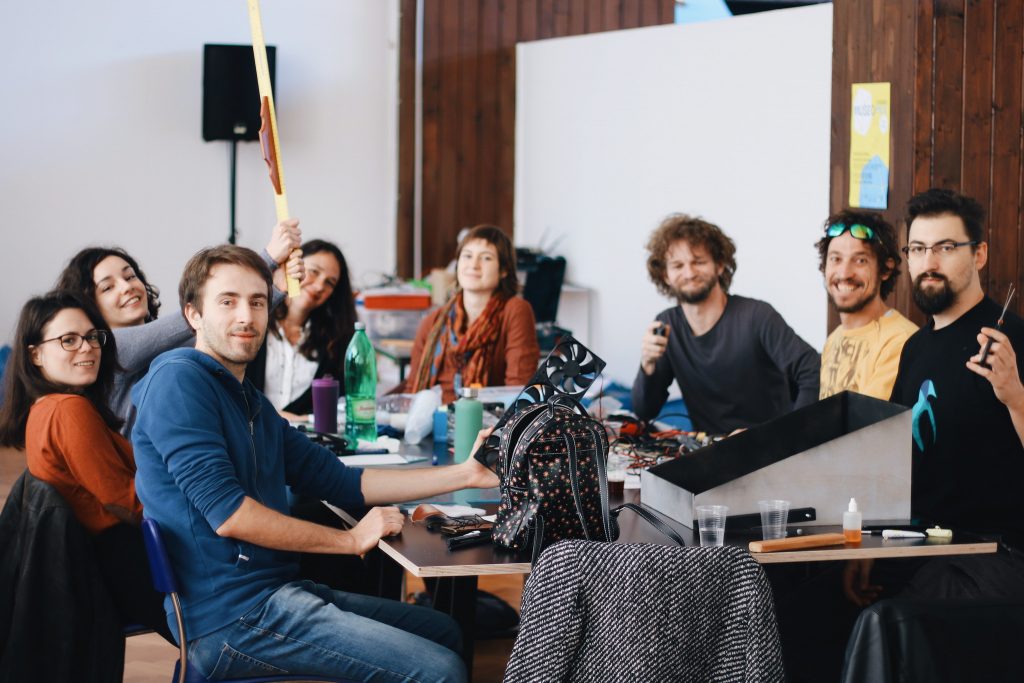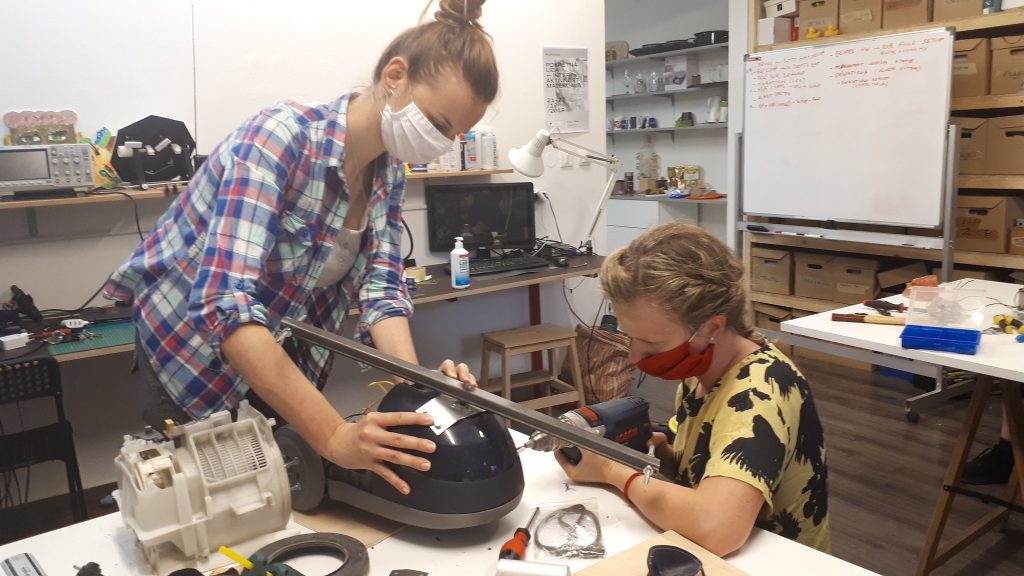“The foundations of our maker culture is a joint symbiosis of humanities, social, formal, natural and applied sciences.”
Deborah Hustić, the creative director, PM, curator and co-founder of Radiona – Zagreb Makerspace in Croatia, met Makery and provided MAX project with her views on “maker culture” and mobility.

Can you introduce yourself? Have you been working as an independent and/or are you involved in cultural/maker organisations?
Deborah Hustić: Hello! I am Deborah Hustić, creative director, PM, curator and co-founder of Radiona – Zagreb Makerspace in Croatia. Radiona – Zagreb Makerspace is a non-profit organisation founded in 2011 with the most incredible community. I am a lot into sound art (open source hardware, sound boxes and synthesizers), wearable technology and device_art in general, basically a large scale of hybrid arts. Professionally, I have also dealt a lot with cultural policy in the areas of creative education, social inclusion, intercultural dialogue in the context of the cultural sector. I work on development of STEAM education, completely obsessed with workshopology and non-formal and informal learning. I also do workshops and trainings in creative electronics, eTextiles, system innovation and design thinking for children, young adults and adults of diverse backgrounds.
Arts and humanities are my formal background, but I switched later to technology and PM. Sometimes I build stuff, sometimes I write, sometimes I perform music, sometimes I curate programs and exhibitions, sometimes I facilitate people and machines. Member of many boards for working groups regarding the creative industries, climate changes, education systems, community building, creating makerspaces and art practices. I like interdisciplinarity and transdisciplinarity practices and that’s the way I hope I do stuff around me. Also founded with my peers a small start-up called Intergalaktik to see a bit the area of ICT and social innovation entrepreneurship as a loooong term plan. An extroverted introvert with a passion for traveling, constantly curious and you wouldn’t believe – passionate about sports, physical activities, devices and goooood books.

Where do you situate your “maker” practice? And how do you define what is known as “maker culture”?
Deborah Hustić: Radiona is a very hybrid form of lab, somewhat very unique because of the diversity of our community. We basically started as a media lab back in 2011. Although the majority wanted actually to have a hackerspace back in the day. When we decided to formalize the status we decided to label ourselves as a makerspace because of the better visibility and diverse community. We are active in many different areas such as non-formal education, exhibitions, research projects, museum projects, socially aware projects, performances and community building above all. What differentiate us from the majority of makerspaces is the fact that we are from the beginning STEAM oriented with a strong social aspect included.
“The foundations of our maker culture is a joint symbiosis of humanities, social, formal, natural and applied sciences. “
We like the combination of all of these areas together with the DIY hands-on approach and open source mind set. I would say, we like cohesion in the way we look at the maker culture. There is no tinkering without curiosity and creativity, no matter what profession you are. We do not look at the maker culture as only the technological approach, there are a lot of social elements included in these processes.
Usually you have this situation where artists are on one side and tech people are on the other side. What we are trying to do is to be a human interface between these areas in order to decrease the communicational gaps and misunderstanding between diverse professions and points of view. As a makerspace we like to demystify technology, so people who are not tech savvy are not so much afraid of it. It is also about breaking these barriers and stereotypes that if you are educated in one area you are not supposed to try out to express yourself in some other area. Life is a changing cycle, thus people have the right to change their interests during a lifespan. Aren’t we? What we like is to use technology and innovation to be directed for good causes, not misusing it. So, in short, our vision of maker culture is about explorations, tolerance and constant curiosity.
Have you participated in mobility programs in the past? Can you elaborate on your experience(s)?
Deborah Hustić: We did a maker-in-residence program within the Creative Museum project back in 2016 and 2018. Our peers from the lab Igor Brkić (maker and heavy geekery programer) and Damir Prizmić (designer and maker) went to Trondheim for a 10-days residence program at the Nordefjeldske Kunstindustrimuseum and Science Center. In 2018 year Damir Prizmić also went there for a residence at the Trondheim Maritime Museum and Science Centre Trondheim.
Igor made a great installation for the museum – a singing/whistling chair that was moving one of its legs when the visitor in the same room was turning its back from the chair. It was very interesting to see the audience’s reactions. The museum gave one of its chairs from the collection because they wanted to present maker culture forces in their own ecosystem. Of course, it was not a rare chair from their collection, it was an object they decided could be used to be combined with open source hardware and some form of hacking. Damir was at the Maritime Museum who wanted to revitalize its a bit old fashioned collection and bring younger audience to the museum. So, he as designer of many exhibitions in Croatia and travelling exhibitions across Europe, got a part of space that looked as a mini attic in order to create a feeling it is a small submarine for children. He also designed the DIY machine kit based on Morse code for mutual communication of underwater vehicles.
Both of them were spending a lot of their time in the local hackerspace – Hackheim. Radiona community always has these special feelings towards the hackerspaces. These are our roots too. And of course, they did workshops with the kits (Synthomir synthesizer and DIY VR glasses kit) we are designing in the lab and took part at the local Maker Faire.
Within this project we had also in our lab two makers for a residence from Finland (2016) and France (2018). Media artist and maker Jari Suominen (FI) did a lecture in our lab on the Finish synth heritage and Erkki Kurenniemi. The synth heritage was basically the topic of his residence and I am very glad we did it already in 2016, because in the last few years media artists and synth geeks are discovering the body of work by Erkki Kurenniemi. Jari also did a workshop with his TANR synthesizer and his sound work built during the residence in our lab was presented during our exhibition Science Fiction – New Parallel Worlds at the Technical Museum Nikola Tesla. He was even included in the art critique we got from the local portal on art and culture. We got a positive review (not that I am influenced a lot by critiques), but I was glad because of our community and the guest. I wonder still nowadays, was it just because we had two international guests on the exhibition or they really liked the concept, if I can be completely honest.
As for the second residence, it was Clement Pasquet from Cap Science in Bordeaux. He was partaking during the residence in the program of the Museomix hackathon at the Technical Museum Nikola Tesla which resulted with four completely working and functional prototypes after only 2,5 days of tinkering and working and exhibition Interactive intervention – the body of the machines. So, Clement was a tech lead of one group at the Museomix and during his residence he explored spirographs – because he is obsessed with them and gave a workshop on the DIY Spirograph kit he developed back in France at Cap Science. During the residence he was focused on exploring the possibilities of Arduino and motors with LEGO parts in order to create drawing machines. He got us back to the topics of drawing machines after 2012 when we did the first ones. This year we decided to focus again on this topic and we produced two exhibitions within the project Drawing machines. We have since 2014 taken part of many Erasmus+ projects that are from the program slot of mobility and we like it. Because it is always about the exchange of practices, knowledge, expirience and mobility.

This year Sars-Cov-2 stopped us a bit from partaking in the international program on mobility because we were not able to travel or to bring people as guests in our lab as we wanted. From abroad we had three Dutch programmers at the residence physically in the lab during the June-August when they were able to travel from the Netherlands with the car, but they are also digitally present via server with sensors exploring the smart city technology which is the topic of their residence.
We are constantly networking in the areas of digital platforms since March 2020 in order to use other channels for mobility for the next few years in order to respond actively in those difficult times for many organisations and individuals.
What were your favorite contexts when you participated in mobility schemes in Europe or Internationally? Workshops? Symposia? Training? Residencies?
Deborah Hustić: Basically all of them because they are part of the program and they reflect the diversity of our lab. I really can not emphasize one more than the other. Each of them have its own specificity and we are enjoying it. You can always make a symposium to be manifold and interactive, whilst at the same time sometimes a workshop can have a format that is more looking as a symposium. It depends on the facilitator and participants. Residencies are a great way to travel and visit spaces and people you probably would never visit on any other occasion, so it gives a lot back to the community if you hit the topic by listening to the community needs. I think this aspect of listening to the needs and having an idea what you want to achieve with a certain program guideline are crucial for enjoying the processes of maker culture in the context of mobility schemes.
What have you been missing to better develop your creative practice? Do you see loopholes in mobility programs regarding maker practices and culture?
Deborah Hustić: This year I got asked by a younger person working in a very important institution what a maker is in my context. She thought it was a term used for a policy maker. I tried to explain what it means and as soon as I mentioned DIY/DIWO she started looking differently at my project proposal, like it is only about the amateur culture. She saw the organization CV and was partly shocked how we managed to actually work with all of these museums and art & science institutions across Europe in past years by only being amateurs. It was super funny to me. I was not even disappointed or offended. It was just something that opened my eyes more widely. Because partly I am used to this. After that episode, I choose more wisely to whom I am going to expose my organisation, frankly. I never spend a lot of time on reading critiques too and primarily have been focused on international networking and domestic community building. People are what matters if you want to have a healthy makerspace. Projects and programs come as a result of investing your time into the people and relationships with them.
To be more concise for your question, as you can see, I like having a broader image, there is still a lack of understanding and programs for maker-in-residence that will actually allow the maker to be only the maker, not necessarily using labels as technical support. If you have an opportunity to get a maker at a residence, have full respect for its geekery and just give them materials and let them work freely. The results might be great.

What would be to you a dream mobility scheme for makers? Would you give priority to travel support, social encounters, technical access or networks building?
Deborah Hustić: Hm, all of them are important aspects. Each could be crucial for a particular area of interest. It depends on the strategic thinking of the organisation, capacities and experiences. Taking into perspective the momentum, traveling seems like an option that is not so realistic in 2021 and I think in 2022 the way it used to be. And it depends what it will look like after that period of time. Let’s say that network building, social encounters, technical access seems to be a priority for the next few years. After everything is relatively normalized, we can then think about the travel support which is also crucial in times of normality (whatever it means).
What is mobility in times of world pandemics? Should we still invest in that? And, considering our travel restrictions, how can we continue to grow and reinforce networks, if we cannot meet one another? And why is that important (or not)?
Deborah Hustić: It is important to continue our work with good and smart planning of activities and to rethink it in order to find new ways of expanding the concept of mobility. We will have to re-think the transport options to use green options. I am very fond of traveling around with a car (electric desirebly), but that is just a matter of preference and of course realistic geographies. We have to see what kind of mobility makes sense, how to be more sensitive and resilient, because we depend on people. Now we see that building informal or formal networks matters more than ever before. The same as people started to reconnect with nature again during the Sars-Cov-2 pandemics, which is scientifically looking, the most dangerous virus in the last 100 years. It is a lot at stake here – human lives, our connection with nature, the way humanity is using technology – for human purpose or only for short term benefit with long term consequences, employment, mental and physical well being. We need maker cultures the same as we need science and arts. Makers’ mobility can be done partly digital, it is not the same, but we have to at least create better and more intuitive platforms for communication. This is the first thing we all witnessed during the pandemic. It could be an opportunity to educate ourselves more on particular skills, but let’s not give up on makers’ mobility. Let’s start better strategic planning and consider how to make it more resilient, coherent and of course inclusive.
Learn more about Radiona – Zagreb Makerspace



